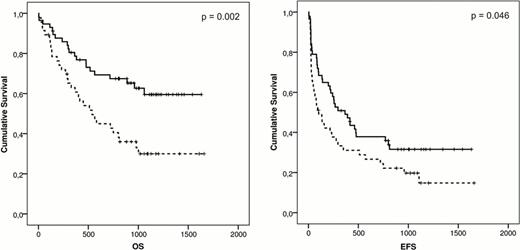Abstract
Abstract 1412
Roundabout receptors – predominantly Robo-1 and Robo-4 – have been described as endothelial-specific markers which may be involved in the establishment of tumor neoangiogenesis. Since hematopoietic and endothelial cells are derived from a common precursor, the hemangioblast, they share many surface antigens such as CD34 or receptors for vascular endothelial growth factor. In this regard, expression of Robo-4 has been demonstrated on hematopoietic stem cells (HSC). It may serve here in cooperation with CXCR4 as an anchor for HSCs within the stem cell niche (Smith-Berdan et al, Cell Stem Cell. 2011;8(1):72–83).
Similar to the normal hematopoietic system, leukemia is believed to derive from a leukemic stem cell (LSC) that serves as reservoir for leukemia cell renewal. Evidence exists that regulation of LSC biology is similar to that of normal hematopoietic stem cells (HSC).
Therefore, the aim of our study was to investigate the expression of Roundabout family members Robo-1, Robo-4 and their ligand Slit-2 in primary AML samples followed by correlation to clinical data.
Pre-treatment samples from 104 patients with newly diagnosed AML who were entered into the AMLSG 07-04 trial were analyzed. The trial was conducted between August 2004 and August 2009 (ClinicalTrials.gov Identifier: NCT00151242). In brief, the trial design was as follows: Patients between 18 and 60 years of age with de novo or secondary AML [excluding patients with t(15;17)] were entered into the study. All patients received two induction courses with cytarabine, idarubicin and etoposide. Patients with complete remission (CR) obtained high dose cytarabine consolidation. At study entry patients were randomized between additional therapy with valproic acid, ATRA, both or none. After an interim analysis the randomization to the valproic acid and the combination arm was suspended.
M-RNA expression values of Robo-1, Robo-4 and Slit-2 were determined in quantitative PCR analysis and normalized to expression of Glyceraldehyde 3-phosphate dehydrogenase. M-RNA of roundabout receptor Robo-4 was expressed in the majority of AML patients (83%) while expression of receptor Robo-1 was only detected in 27% of AML patients. Eighteen percent of AML patients showed expression of ligand Slit-2.
In order to analyze the prognostic impact of gene expression levels, gene expression variables were categorized into two groups guided by conditional interference tree models for overall survival (Hothorn et al, J Comp Graph Stat, 2006; 15(3):651–674). Since no reasonable cut-off level for group separation was found for Robo-1 and Slit-2, the cohort was sub-divided in expressors and non-expressors for both gene expression variables.
Clinical outcome was correlated to gene expression variables. For Robo-1 and Slit-2, no significant impact on survival could be observed. However, high Robo-4 expression (cut-off >0.095) had a significant impact on overall (OS) and event-free survival (EFS; p=0.002 and p=0.046, respectively; figure 1). The CR rate was 54% for the high Robo-4 expression group compared to 71% in the low Robo-4 expression group (p=0.103).
Primary AML samples were analyzed for Robo-4 protein expression using flow cytometry (n=42). Robo-4 protein expression was observed in 81% of AML patients, although in most cases the expression was restricted to a very small proportion of AML cells. Double-staining for CD34 and Robo-4 revealed that a proportion of CD34+ showed co-expression of Robo-4 ranging from 0% to 22% of CD34+/Robo-4+ cells supporting that Robo-4 expression is restricted to a distinct CD34-sub-population possibly representing the LSC population.
In conclusion, Robo-4 represents a negative prognostic marker in AML and therapeutic approaches against Robo-4 might preferentially target leukemic stem cells.
Impact of Robo-4 expression on clinical outcome. A significant difference between high expression of Robo-4 (dashed line) or low expression (continuous line) was determined for overall (OS) and event-free survival (EFS).
Impact of Robo-4 expression on clinical outcome. A significant difference between high expression of Robo-4 (dashed line) or low expression (continuous line) was determined for overall (OS) and event-free survival (EFS).
Fiedler:Pfizer Inc.: Consultancy, Research Funding; Novartis: Consultancy, Research Funding.
Author notes
Asterisk with author names denotes non-ASH members.


